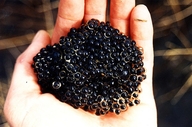|
Rana sevosa Goin and Netting, 1940
Dusky Gopher Frog Subgenus: Pantherana | family: Ranidae genus: Rana |
|
Taxonomic Notes: This species was placed in the genus Lithobates by Frost et al. (2006). However, Yuan et al. (2016, Systematic Biology, doi: 10.1093/sysbio/syw055) showed that this action created problems of paraphyly in other genera. Yuan et al. (2016) recognized subgenera within Rana for the major traditional species groups, with Lithobates used as the subgenus for the Rana palmipes group. AmphibiaWeb recommends the optional use of these subgenera to refer to these major species groups, with names written as Rana (Aquarana) catesbeiana, for example. |
|
 © 2003 Stephen C. Richter (1 of 13) |
|
|
|
Description Adult R. sevosa range in size from 2.0 to 3.8 inches snout-to-vent length (SVL) (Richter and Seigel, 2002). On average, males (2.0-3.3 inches SVL) are smaller than females (2.5-3.8 inches SVL), but the degree of sexual dimorphism varies between years (Richter and Seigel, 2002). Juveniles that have recently undergone metamorphosis range in size from 0.9 to 1.5 inches SVL (Richter and Seigel, 2002). Dorsal coloration is always dark (in contrast to R. capito, which is often called the "white frog") but varies from virtually uniform deep gray to a pattern of reddish brown or dark brown spots on a background of gray or brown (Conant and Collins, 1998). Distribution and Habitat Country distribution from AmphibiaWeb's database: United States U.S. state distribution from AmphibiaWeb's database: Mississippi
Gopher frogs use two distinct habitats throughout the year: a non-breeding habitat and a breeding habitat. Non-breeding seasonal habitat is typically an upland longleaf pine forest where the frogs reside in gopher tortoise burrows, small mammal burrows, or holes associated with dead trees (Dundee and Rossman 1989; Richter et al. 2001). Breeding seasonal habitats are usually relatively shallow, upland ephemeral ponds with emergent and submergent vegetation. Because of this dichotomy in habitat use, frogs must migrate to and from the pond during the breeding season. Life History, Abundance, Activity, and Special Behaviors Dusky Gopher Frogs are winter-breeders, and adults begin to move toward their breeding pond at the onset of winter rains, with males entering the pond earlier and leaving later than females (Richter and Seigel, 2002). The call has been characterized as a deep snore and likened to the distant roar of an outboard motor (Conant and Collins, 1998). Little is known about their social structure and whether males are territorial, but male-male combat has been observed (Doody et al., 1995). Breeding lasts for only a short period. Female movement away from the pond begins immediately after the initial deposition of egg masses, and males tend to exit after the last egg mass has been deposited (Richter and Seigel, 2002). Metamorphs typically emerge between 30 May and 30 July and exit the pond through specific migratory corridors (Richter and Seigel, 2002). Large annual variation exists in reproduction in terms of numbers of adults present, number of egg masses deposited, and number of juveniles emerging from the pond (i.e., frequency and intensity of reproductive success) (Richter et al., 2003). Females deposit a single clutch ranging in size from 500 - 2800 eggs in Mississippi (Richter, 1998). Clutch size estimates in Louisiana ranged from 3000 - 7000 (Volpe, 1957; Dundee and Rossman, 1989). Developmental times ranged from 141 - 155 days at 20 degrees C in the laboratory (Volpe, 1957) and from 81 - 179 days in the field (Richter et al., 2003). Size at metamorphosis can vary widely among years, primarily as a result of hydroperiod length (Richter et al., 2003). Volpe (1957) reported the mean size of laboratory-reared metamorphs to be 1.1 inches SVL. Richter and Seigel (2002) found variation across years in metamorphic body sizes primarily due to hydroperiod: mean SVL = 1.4 inches (n = 213; range = 1.2 - 1.7 inches) and mean mass = 5.0 grams (g) (n = 213; range = 3.2 - 6.8 g); 1998: mean SVL = 1.2 inches (n = 813; range = 0.9 - 1.4 inches) and mean mass = 2.6 g (n = 813; range = 1.5 - 3.9 g). Reproductive success (measured as proportion of metamorphic animals emerging compared to number of eggs deposited) was low (0.35 - 4.9%; Richter et al., 2003). The estimated minimum age at maturity for males is between 123 and 184 days (4 - 6 months) at a mean length of 2.2 inches SVL and mass of 18.8 g (Richter and Seigel, 2002). Average post-metamorphic growth for males was 0.8 inches SVL (37% increase) and 13.8 g (73% increase) (Richter and Seigel, 2002). The minimum age at maturity for females is estimated at 2 - 3 years. Richter and Siegel (2002) found that survival was high, 65 to 92%, during the breeding season; however, the rate at which adults returned to breed from one year to the next was low (16 - 22%). Richter et al. (2001) found that radio-tracked adults moved very short distances (<300m) from the pond. Out of 12 radio-tracked frogs, they moved on average 1 - 5 times during the course of 24-88 days. All movement was correlated with rainfall events and the final locations for all frogs tracked were underground retreats associated with stump holes, root mounds of fallen trees or small mammal burrows. Richter et al. (2001) also noted that, after movement to their upland refuge (typically holes associated with dead trees or small mammal burrows), they come out and forage above ground near their burrow. This regular foraging activity creates a distinct resting area, also called a "platform" by some researchers, outside each frog's burrow where the soil has been cleared of vegetation and smoothed by the frog's constant use. Trends and Threats In 2011, the USFW designated critical habitat in St. Tammany Parish, Louisiana, and in Harrison, Jackson, and Perry Counties, Mississippi, for the Dusky Gopher Frog. Upland habitat and wetland restoration has begun in many of these sites in Mississippi. See the USFW's press release for more information. Possible reasons for amphibian decline General habitat alteration and loss Comments On April 27, 2013 the Associated Press reported that Rana sevosa was found at a new breeding site in a renovated pond less than one mile from Glen's Pond in the DeSoto National Forest. This species was featured as News of the Week on 6 July 2020: The Dusky Gopher Frog (Rana sevosa) is an IUCN Critically Endangered species native to the southern Coastal Plain of the United States, but which has been reduced to only one known population. Several measures have been adopted to conserve the species including captive breeding with artificial fertilization paired with reintroductions. Roznik and Reichling (2020) evaluated reintroduction methods for the species to maximize these efforts by radio-tracking released individuals. They found relatively high survival rates (76%) for released juveniles with higher survival rates for individuals released near burrows in fire-maintained habitats than individuals released near ponds. On average, individuals released near ponds also traveled further, likely reflecting their longer search for suitable shelter. Sheltering underground improved survival rates by 22%. Although long-term monitoring is still needed, these findings provide optimistic evidence that artificial fertilization and captive rearing has minimal effects on the species' ability to successfully transition to native habitat as long as suitable fire-maintained, open-canopy long-leaf pine forest habitat is available. (AChang)
References
Conant, R. and Collins, J.T. (1998). A Field Guide to Reptiles and Amphibians of Eastern and Central North America. 3rd Edition. Houghton Mifflin Company, Boston, Massachusetts. Doody, J. S., Young, J. E., and Johnson, G. N (1995). ''Rana capito combat.'' Herpetological Review, 26, 202-203. Dundee, H. A. and Rossman, D. A. (1989). The Amphibians and Reptiles of Louisiana. Louisiana State University Press, Baton Rouge. Goin, C. J., and Netting, M. G. (1940). ''A new gopher frog from the Gulf Coast, with comments upon the Rana areolata group.'' Annals of the Carnegie Museum, 28, 137-169. Richter, S. C. (1998). The demography and reproductive biology of gopher frogs, Rana capito, in Mississippi. Unpublished dissertation, Southeastern Louisiana University, Hammond, Louisiana. Richter, S. C. (2000). ''Larval caddisfly predation on the eggs and embryos of Rana capito and Rana sphenocephala.'' Journal of Herpetology, 34(4), 590-593. Richter, S. C., Young, J. E., Johnson, G. N., and Seigel, R. A. (2003). ''Stochastic variation in reproductive success of a rare frog, Rana sevosa: implications for conservation and for monitoring amphibian populations.'' Biological Conservation, 111(2), 171-177. Richter, S. C., Young, J. E., Seigel, R. A., and Johnson, G. N. (2001). ''Postbreeding movements of the Dark Gopher Frog, Rana sevosa Goin and Netting: implications for conservation and management.'' Journal of Herpetology, 35(2), 316-321. Richter, S. C., and Seigel, R. A. (2002). ''Annual variation in the population ecology of the endangered gopher frog, Rana sevosa Goin and Netting.'' Copeia, 2002(4), 962-972. United States Fish and Wildlife Service (2011). ''Endangered and Threatened Wildlife and Plants; Designation of Critical Habitat for Mississippi Gopher Frog.'' Federal Register, 76(187). Volpe, E. P. (1957). ''The early development of Rana capito sevosa.'' Tulane Studies in Zoology, 5, 207-225. Young, J. E. and Crother, B. I. (2001). ''Allozyme evidence for the separation of Rana areolata and Rana capito and for the resurrection of Rana sevosa.'' Copeia, 2001(2), 382-388. Originally submitted by: Stephen C. Richter and Rebecca A. Doubledee (first posted 2003-06-10) Edited by: Kellie Whittaker, Ann T. Chang, Michelle Koo (2020-07-05) Species Account Citation: AmphibiaWeb 2020 Rana sevosa: Dusky Gopher Frog <https://amphibiaweb.org/species/5939> University of California, Berkeley, CA, USA. Accessed Jul 26, 2024.
Feedback or comments about this page.
Citation: AmphibiaWeb. 2024. <https://amphibiaweb.org> University of California, Berkeley, CA, USA. Accessed 26 Jul 2024. AmphibiaWeb's policy on data use. |




 Map of Life
Map of Life Featured in Amazing Amphibians, March 18, 2013
Featured in Amazing Amphibians, March 18, 2013